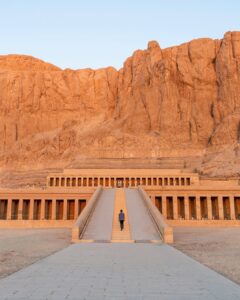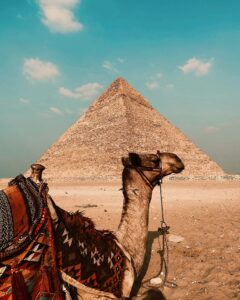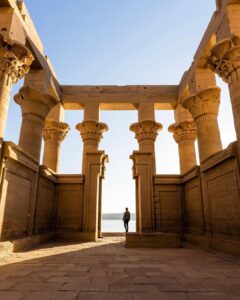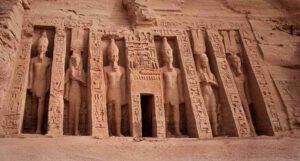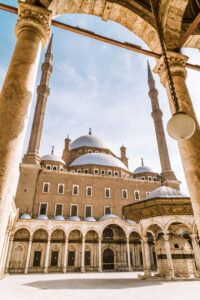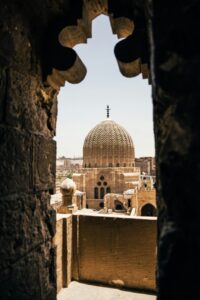Introduction to the Temple of Seti I
Built during the New Kingdom period, the Temple of Seti I is dedicated to the worship of Seti I, one of ancient Egypt’s most illustrious pharaohs. Its sprawling complex and intricate reliefs offer insights into the religious beliefs and royal traditions of the time.
Historical Significance
Seti I, renowned for his military conquests and ambitious building projects, sought to reaffirm the divine legitimacy of his rule through the construction of monumental temples. The Temple of Seti I served as a focal point for religious rituals and royal ceremonies, honoring the gods and perpetuating the cult of the pharaoh.
Location and Architecture
Situated in the ancient city of Abydos, the Temple of Seti I commands a strategic position along the Nile River, linking the upper and lower regions of Egypt. Its architectural design, characterized by towering columns, intricate carvings, and expansive courtyards, reflects the grandeur of New Kingdom temples.
Discovery and Excavation
The Temple of Seti I lay buried beneath layers of sand and debris for centuries until its rediscovery by archaeologists in the 19th century. Excavations led by renowned Egyptologists such as Flinders Petrie and Margaret Murray unearthed its majestic ruins, shedding light on Egypt’s royal past.
Mythology and Symbolism
The temple’s reliefs and inscriptions depict scenes from Egyptian mythology, including the divine birth of pharaohs and their symbolic journey to the afterlife. Rich in symbolism and religious iconography, these artworks served to glorify the pharaoh’s divine status and ensure his eternal legacy.
Restoration Efforts
In recent years, efforts have been made to preserve and restore the Temple of Seti I, safeguarding its fragile structures from the ravages of time and environmental damage. Conservation projects aim to stabilize the temple’s foundations, protect its intricate carvings, and enhance visitor accessibility.
Visitor Experience
Today, the Temple of Seti I welcomes visitors from around the world, offering a glimpse into the splendor of ancient Egyptian civilization. Guided tours provide insight into the temple’s history and significance, allowing visitors to explore its majestic halls and marvel at its ornate reliefs.
Cultural Impact
The Temple of Seti I continues to inspire awe and reverence among scholars, artists, and enthusiasts alike. Its richly decorated walls and monumental architecture serve as a testament to the artistic and spiritual achievements of ancient Egypt, leaving an indelible mark on world culture.
Modern-Day Relevance
Beyond its historical significance, the Temple of Seti I holds relevance in contemporary discussions surrounding heritage preservation and cultural identity. Its preservation underscores the importance of safeguarding our shared human heritage for future generations.
Conservation Challenges
Despite ongoing conservation efforts, the Temple of Seti I faces numerous challenges, including the threat of urban encroachment, pollution, and climate change. Balancing the need for preservation with the demands of tourism and development remains a delicate balancing act.
Research and Interpretation
Scholars continue to study and interpret the inscriptions and reliefs of the Temple of Seti I, seeking to unlock its secrets and unravel the mysteries of ancient Egyptian religion and society. Advances in technology, such as laser scanning and digital modeling, offer new avenues for exploration and discovery.
Conclusion
In conclusion, the Temple of Seti I stands as a testament to the enduring legacy of ancient Egypt’s pharaohs and the enduring power of human creativity and devotion. Its majestic ruins offer a window into a bygone era, inviting visitors to marvel at the wonders of one of history’s greatest civilizations.
FAQs
Q: Can visitors enter the inner sanctum of the Temple of Seti I? A: No, access to the inner chambers of the temple is restricted to authorized personnel for conservation purposes.
Q: What is the significance of the reliefs found within the temple? A: The reliefs depict scenes from Egyptian mythology and royal rituals, serving to glorify the pharaoh and ensure his divine legacy.
Q: How long did it take to construct the Temple of Seti I? A: The temple was constructed over a period of approximately 15 years during the reign of Seti I.
Q: Are there any special events or exhibitions held at the Temple of Seti I? A: Periodically, special events and exhibitions may be organized at the temple to showcase new discoveries or highlight its cultural significance.
Q: What are some of the challenges facing the conservation of the temple? A: Conservation efforts face challenges such as environmental damage, urban development, and the need to balance preservation with visitor access.










